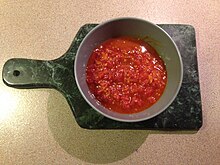Contents

Stewed tomatoes is a dish made by cooking tomatoes in a stew. It is often cooked with garlic and herbs, and consumed with bread or meat.[1] It is eaten as either a main dish or a side dish. Stewed tomatoes are sometimes prepared in the United States on occasions such as Thanksgiving.[2]
History
Food historian Andrew F. Smith stated that stewed tomatoes became popular in the United States in the early 19th century, with recipes appearing as early as 1829, as tomatoes in general became popular in the United States. Stewed tomatoes commonly appeared in restaurants in the 1840s.[3] Canned stewed tomatoes were common starting in the 1940s.[4] Currently, the dish is prepared on special occasions like Thanksgiving, in American kitchens, often as a combination with casseroles and puddings.[2] Noted food historian Betty Fussell stated that stewed tomatoes were one of the most loved and common dishes for her grandfather's generation. She adds that she remembers heating tomatoes and adding butter, salt and sugar in it, to create a dish that was served with bread on a daily basis.[2] In 2019, Dayton.com, a news website based in Dayton, Ohio, reported that stewed tomatoes were popular in Dayton restaurants.[5]
Preparations
The earliest recipe of the dish can be found in the work The Frugal Housewife by Lydia Maria Child published in the year 1829.[8] Child has explained a simple recipe of a catsup created by boiling tomatoes in hot water and adding herbs and garlic which can be served as a side dish with chowder and meat.[8] However, over the decades there have been variations.
Preparing
Stewed tomato recipes often include sugar, peppers, onions, and salt. Stewed tomatoes can be canned with tomato juice and other ingredients.[9]
See also
References
- ^ "What are Stewed Tomatoes? (with pictures)". wiseGEEK. Retrieved 2019-05-09.
- ^ a b c TRIBUNE, Jennifer Day, SPECIAL TO THE (22 November 2009). "A taste of culinary history". chicagotribune.com. Retrieved 2019-05-09.
{{cite web}}: CS1 maint: multiple names: authors list (link) - ^ Smith, Andrew F. (2001). The Tomato in America: Early History, Culture, and Cookery. University of Illinois Press. ISBN 9780252070099.
- ^ "HISTORY OF THE PRODUCTION OF TOMATOES FOR PROCESSING IN THE U.S.A." www.actahort.org. Retrieved 2019-06-11.
- ^ Robinson, Amelia. "Why is Dayton so crazy about stewed tomatoes?". dayton. Retrieved 2019-05-09.
- ^ United States Food and Drug Administration (2024). "Daily Value on the Nutrition and Supplement Facts Labels". Retrieved 2024-03-28.
- ^ National Academies of Sciences, Engineering, and Medicine; Health and Medicine Division; Food and Nutrition Board; Committee to Review the Dietary Reference Intakes for Sodium and Potassium (2019). Oria, Maria; Harrison, Meghan; Stallings, Virginia A. (eds.). Dietary Reference Intakes for Sodium and Potassium. The National Academies Collection: Reports funded by National Institutes of Health. Washington (DC): National Academies Press (US). ISBN 978-0-309-48834-1. PMID 30844154.
{{cite book}}: CS1 maint: multiple names: authors list (link) - ^ a b Kraig, Bruce (2013-01-31). The Oxford Encyclopedia of Food and Drink in America. OUP USA. ISBN 9780199734962.
- ^ Featherstone, Susan (2016). "Canned tomato products". A Complete Course in Canning and Related Processes. Food Science, Technology and Nutrition. pp. 199–228. doi:10.1016/B978-0-85709-679-1.00005-2. ISBN 9780857096791.

